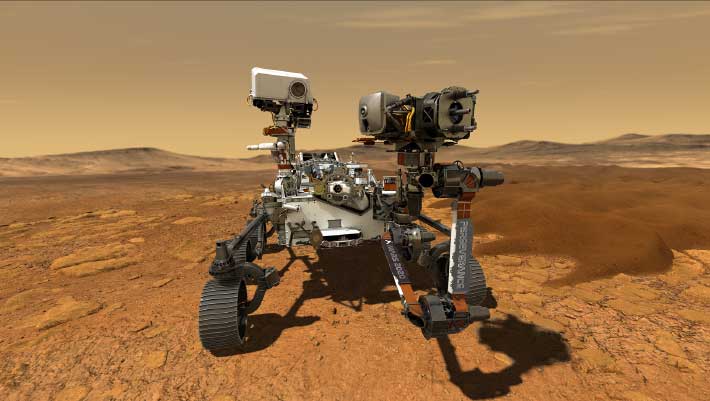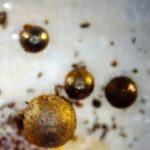The Scanning Habitable Environments with Raman and Luminescence for Organics and Chemicals (SHERLOC) instrument onboard NASA’s Perseverance rover has detected several species of aromatic organic molecules in the Máaz and Séítah formations of Jezero crater, Mars. The discovery suggests that a more complex geochemical cycle than previously thought may have existed in the past of the Red Planet.
This artist’s concept depicts NASA’s Mars rover Perseverance on the surface of the Red Planet. Image credit: NASA / JPL-Caltech.
The presence and distribution of preserved organic matter on the surface of Mars can provide key information about the Martian carbon cycle and the potential of the planet to host life throughout its history.
Several types of organic molecules have been previously detected in Martian meteorites and at Gale crater, Mars.
Evaluating the diversity and detectability of organic matter elsewhere on the Red Planet is important for understanding the extent and diversity of Martian surface processes and the potential availability of carbon sources.
“There are multiple origin hypotheses for the presence of organic matter on Mars from meteorite and mission studies,” said Dr. Sunanda Sharma from NASA’s Jet Propulsion Laboratory and colleagues.
“These include formation through water-rock interactions or electrochemical reduction of carbon dioxide, or deposition from exogenous sources such as interplanetary dust and meteoritic infall, although a biotic origin has not been excluded.”
“Understanding the fine-scale spatial association between minerals, textures and organic compounds has been crucial in explaining the potential pools of organic carbon on Mars.”
“The SHERLOC instrument onboard the Perseverance rover is a tool that enables this on the Martian surface.”

Jezero crater, one of the paleolakes examined in the study, is a paleolake and potential landing site for NASA’s Mars 2020 rover mission to look for past life; the outlet canyon carved by overflow flooding is visible in the upper right side of the crater; ancient rivers carved the inlets on the left side of the crater. Image credit: NASA / Tim Goudge.
In their study, the authors analyzed SHERLOC’s observations in Máaz and Séítah, two formations on the floor of Jezero crater.
Signals of organic molecules were detected on all ten targets SHERLOC observed in the crater floor, concentrated in Máaz more than in Séítah, showing diverse mineral association and spatial distribution that may be unique to each formation.
The diversity among these observations may provide insight into different ways organic matter may have originated: potentially through deposition by water, or through synthesis with volcanic materials.
“Our results indicate a more complex organic geochemical cycle may have existed than has been described from previous in situ measurements on Mars, as evidenced by several distinct pools of possible organics,” the researchers said.
“In summary, key building blocks for life may have been present over an extended period of time (from at least roughly 2.3-2.6 billion years ago), along with other as yet undetected chemical species that could be preserved within these two potentially habitable paleo-depositional settings in Jezero crater.”
A paper on the findings was published in the journal Nature.
_____
S. Sharma et al. Diverse organic-mineral associations in Jezero crater, Mars. Nature, published online July 12, 2023; doi: 10.1038/s41586-023-06143-z




